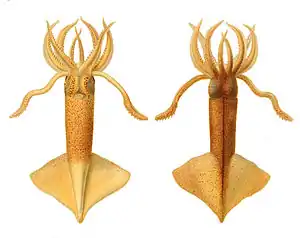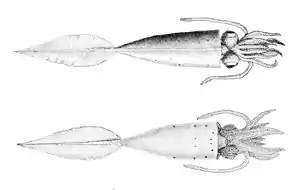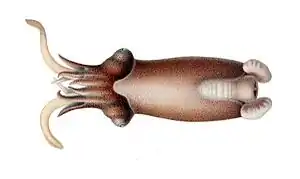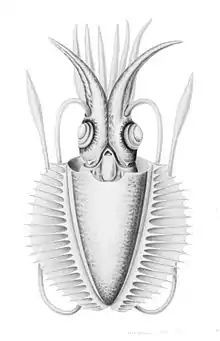 Standard measurements for squid, showing the location of the fins and tail in different configurations |
 Measurement of fin angle in a squid with sagittate fins |
Cephalopod fins, sometimes known as wings,[1] are paired flap-like locomotory appendages. They are found in ten-limbed cephalopods (including squid, bobtail squid, cuttlefish, and Spirula) as well as in the eight-limbed cirrate octopuses and vampire squid. Many extinct cephalopod groups also possessed fins. Nautiluses and the more familiar incirrate octopuses lack swimming fins. An extreme development of the cephalopod fin is seen in the bigfin squid of the family Magnapinnidae.[2]
Fins project from the mantle and are often positioned dorsally. In most cephalopods, the fins are restricted to the posterior end of the mantle, but in cuttlefish and some squid they span the mantle's entire length.
Fin attachment varies greatly among cephalopods, though in all cases it involves specialised fin cartilage (which reaches its greatest development in Octopodiformes).[3] A fin may be attached to the internal shell or shell remnant (such as the gladius), to the opposite fin, to the mantle, or a combination of these.[4]

Tail and secondary fins
Certain squid species possess a tail, which is an extension of the body past the fins.[5] The tail may be said to start at "the point where a hypothetical line, continuous with the broad posterior edge of the fin, crosses the midline of the body".[1] This tail may be lost with age (as in most paralarval chiroteuthids)[6] or remain through sexual maturity (as in Grimalditeuthis). Grimalditeuthis and larval Chiroteuthis are unusual in that they possess a pair of flotation devices or "secondary fins" attached to the tail. The vampire squid (Vampyroteuthis infernalis) also has two pairs of fins during a brief period of its ontogeny, and secondary fins have been reported in the extinct Trachyteuthis.[7]
.jpg.webp)
Fin morphology and placement
Cephalopod fin morphology is highly variable. The fins may be large and muscular, extending for the entire length of the mantle, or greatly reduced (sometimes less than 10% ML) and restricted to the mantle's posterior end.[8] Fin placement in cephalopods is often termed normal, terminal, or subterminal, depending on their position with respect to the muscular mantle.[5]
Eight major fin shapes can be distinguished among the Decapodiformes: sagittate (the most common shape in squid), rhomboid, circular/elliptical, lanceolate, ear-shaped, ribbed, lobate, and skirt-like.[9]
 Ventral (left) and dorsal aspects of Onychoteuthis banksii, showing classic sagittate fins
Ventral (left) and dorsal aspects of Onychoteuthis banksii, showing classic sagittate fins.jpg.webp) The diamondback squid, Thysanoteuthis rhombus, has full-length rhomboid fins
The diamondback squid, Thysanoteuthis rhombus, has full-length rhomboid fins Mastigoteuthis magna has very large circular fins, characteristic of its family, Mastigoteuthidae
Mastigoteuthis magna has very large circular fins, characteristic of its family, Mastigoteuthidae Galiteuthis phyllura in dorsal (top) and ventral views, showing its lanceolate fins
Galiteuthis phyllura in dorsal (top) and ventral views, showing its lanceolate fins
 Spirula spirula has small ear-shaped fins on either side of a terminal photophore
Spirula spirula has small ear-shaped fins on either side of a terminal photophore The highly distinctive ribbed fins of Chtenopteryx sicula
The highly distinctive ribbed fins of Chtenopteryx sicula Skirt-like fins spanning the length of the mantle are characteristic of sepiids, such as this Sepia officinalis
Skirt-like fins spanning the length of the mantle are characteristic of sepiids, such as this Sepia officinalis
References
- 1 2 Young, R.E., M. Vecchione & K.M. Mangold (1999). Cephalopoda Glossary. Tree of Life Web Project.
- ↑ Vecchione, M. & R.E. Young (1998). The Magnapinnidae, a newly discovered family of oceanic squid (Cephalopoda: Oegopsida). South African Journal of Marine Science 20(1): 429–437. doi:10.2989/025776198784126340
- ↑ Young, R.E., M. Vecchione & K.M. Mangold (2000). Cephalopoda Fin Cartilage. Tree of Life Web Project.
- ↑ Young, R.E., M. Vecchione & K.M. Mangold (2001). Cephalopod Fin Attachment. Tree of Life Web Project.
- 1 2 Young, R.E., M. Vecchione & K.M. Mangold (2001). Cephalopod Fin Position. Tree of Life Web Project.
- ↑ Vecchione, M., B.H. Robison & C.F.E. Roper (1992). "A tale of two species: tail morphology in paralarval Chiroteuthis" (PDF). Proceedings of the Biological Society of Washington 105(4): 683–692.
- ↑ Donovan, D.T., L.A. Doguzhaeva & H. Mutvei (2003). "Two pairs of fins in the late Jurassic coleoid Trachyteuthis from southern Germany" (PDF). Archived from the original (PDF) on 2017-08-12. Retrieved 2012-12-22. Berliner Paläobiologische Abhandlungen 3: 91–99.
- ↑ Young, R.E., M. Vecchione & K.M. Mangold (2001). Cephalopod Fin Length. Tree of Life Web Project.
- ↑ Young, R.E., M. Vecchione & K.M. Mangold (2001). Decapodiform Fin Shapes. Tree of Life Web Project.


